
Clan Campbell is a Highland Scottish clan, historically one of the largest and most powerful of the Highland clans. The Clan Campbell lands are in Argyll and within their lands lies Ben Cruachan. The chief of the clan became Earl of Argyll and later Duke of Argyll.

Clan Mackintosh is a Scottish clan from Inverness in the Scottish Highlands. The chiefs of the clan are the Mackintoshes of Mackintosh. Another branch of the clan, the Mackintoshes of Torcastle, are the chiefs of Clan Chattan, a historic confederation of clans.
Cawdor is a village and parish in the Highland council area, Scotland. The village is 5 miles south-southwest of Nairn and 12 miles east of Inverness. The village is in the Historic County of Nairnshire.
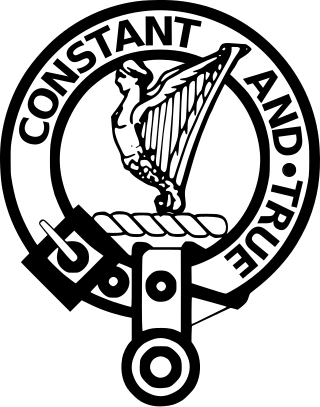
Clan Rose is a Scottish clan of the Scottish Highlands.

Kilravock Castle is located near the village of Croy, between Inverness and Nairn, in the council area of Highland, Scotland. It was begun around 1460 and has been the seat of the Clan Rose since that time. The castle is a composite of a 15th-century tower house and several later additions. The original name for the castle was Cill Rathaig; Scottish Gaelic meaning "church at the small circular fort".
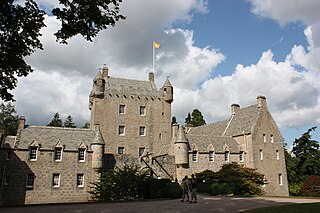
Cawdor Castle is a castle in the parish of Cawdor in Nairnshire, Scotland. It is built around a 15th-century tower house, with substantial additions in later centuries. Originally a property of the Calder family, it passed to the Campbells in the 16th century. It remains in Campbell ownership, and is now home to the Dowager Countess Cawdor, stepmother of Colin Campbell, 7th Earl Cawdor.

Croy is a village between Inverness and Nairn, in the Highland council area in Scotland. The village looks over the Moray Firth and is located a few miles from Inverness Airport. The estimated population of the village is 498 according to the adjusted 2011 census.

Clan Campbell of Cawdor is a highland Scottish clan and a branch of the larger Clan Campbell. While the clan is recognised by the Standing Council of Scottish Chiefs, the clan does not have a clan chief recognised by the Standing Council of Scottish Chiefs. Also, because the clan does not have a clan chief recognised by the Lord Lyon King of Arms it is considered an armigerous clan. The head of the Clan Campbell of Cawdor is the Earl Cawdor, currently held by Colin Campbell.

Clan Bissett is a Scottish clan. The clan is recognised by the Lord Lyon King of Arms but does not have a clan chief recognised by the Lord Lyon King of Arms, therefore the clan has no standing under Scots Law. Clan Bissett is considered an armigerous clan, meaning that it is considered to have had at one time a chief who possessed the chiefly arms; however, no one at present is in possession of such arms. The surname Bissett is also considered a sept of the Clan Fraser of Lovat.
John Campbell of Stackpole Court and Cawdor (1695–1777), was a British politician. He was a Member of Parliament (MP) for Pembrokeshire, Nairnshire, Inverness Burghs and Corfe Castle.
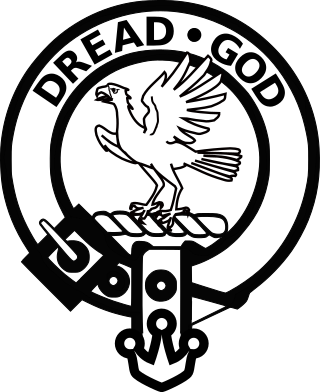
Clan Munro is a Highland Scottish clan. Historically the clan was based in Easter Ross in the Scottish Highlands. Traditional origins of the clan give its founder as Donald Munro who came from the north of Ireland and settled in Scotland in the eleventh century, though its true founder may have lived much later. It is also a strong tradition that the Munro chiefs supported Robert the Bruce during the Wars of Scottish Independence. The first proven clan chief on record however is Robert de Munro who died in 1369; his father is mentioned but not named in a number of charters. The clan chiefs originally held land principally at Findon on the Black Isle but exchanged it in 1350 for Estirfowlys. Robert's son Hugh who died in 1425 was the first of the family to be styled "of Foulis", despite which clan genealogies describe him as 9th baron.
Sir John Campbell was a Scottish nobleman and the eponymous ancestor of the Campbells of Cawdor.
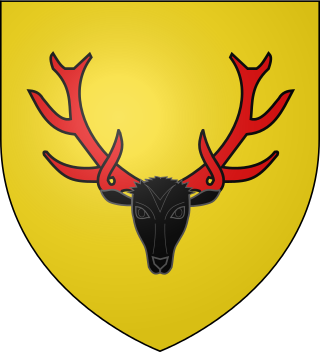
Thane of Calder was a title of nobility in the Kingdom of Scotland.

Rait Castle is a ruined hall-house castle dating from the thirteenth century, situated just south of Nairn near Inverness, Scotland. It is a scheduled monument.
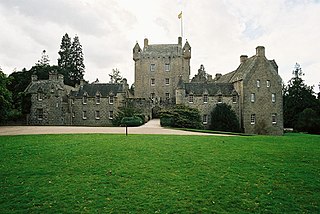
The Battle of Daltullich was a Scottish clan battle that took place in the autumn of 1499 at a place called Daltullich which is near to Strathnairn in the Scottish Highlands. It was fought between men of the Clan Calder and Clan Campbell. The heiress to the chiefship of the Clan Calder, Muriel, was carried away as agreed by men of the Clan Campbell to marry into the Campbell family, but they were pursued by her paternal uncles who tried to prevent this from happening.

Clan MacPhail or the Sons of Paul is a Scottish clan of the Scottish Highlands. Known in Scottish Gaelic as Conchie Dhu or Condochy Doye, the clan is mainly associated with the confederation of Clan Chattan.
Malcolm Beg Mackintosh was the tenth chief of the Clan Mackintosh, a Scottish clan of the Scottish Highlands. He was also chief of the confederation of clans known as the Clan Chattan.
Lachlan Mor Mackintosh, 16th of Mackintosh was the chief of the Clan Mackintosh, a Scottish clan of the Scottish Highlands. He was also chief of the confederation of clans that was known as the Clan Chattan.
This article collects the History of Nairn, Nairn is a town and Royal burgh in the Highland council area of Scotland. It is an ancient fishing port and market town around 17 miles (27 km) east of Inverness. It is the traditional county town of Nairnshire.

Hugh Rose, 15th Baron of Kilravock and Chief of Clan Rose, (1663–1732) was one of the Scottish representatives to the first Parliament of Great Britain as MP for Nairnshire.















